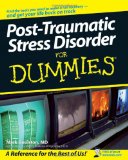



Post-Traumatic Stress Disorder
Dennis B. Kottler, MD
Westlake Village, CA
Appointments: 818-991-8376
Email: doc@psychiatrix.com
Click images for more information:
RECENT DEVELOPMENTS: In addition to traditional PTSD, psychiatrists are beginning to recognize a form of PTSD related to ONGOING trauma, such as experienced over time in an abusive relationship or work environment. Examples include severe emotional or physical trauma by a spouse or by an abusive coworker or boss. In this situation, a person often feels powerless and trapped with no good options. After leaving this situation, it is not uncommon to develop many of the symptoms of traditional PTSD (described below).
PTSD by PROXY can occur when a person, for example, a child, has become aware of the horrific and often life-threatening treatment a parent has endured. Perhaps, most dramatically this has occurred in children of holocaust survivors. The child experiences what he has heard or imagined, as though he had been the victim, himself. Symptoms may resemble those of traditional PTSD. There may be additional features, such as persistent, free-floating anger, distrust, and a disinclination to have children.
Traditional PTSD relates to a person's experience of a major life trauma. First identified during World War I, it was called "shell shock" or "combat fatigue." The terrorist attacks of 9/11 created renewed interest in PTSD.
What are the hallmarks of PTSD?
PTSD, according to the DSM IV (Diagnostic and Statistical Manual of Mental Disorders - 4th edition), can occur when: a person has been exposed to a traumatic event in which both of the following were present:
1 - The person experienced, witnessed, or was confronted with an event or events that involved actual or threatened death or serious injury, or a threat to the physical integrity of self or others and,
2- The person's response involved intense fear, helplessness, or horror. Note: In children, this may be expressed instead by disorganized or agitated behavior.
PTSD symptoms:
Re-experiencing including one or more of the following:
Recurrent and intrusive distressing recollections in the form of images or thoughts.
Recurrent distressing dreams of the event.
Acting or feeling as if the traumatic event were recurring.
Distress or physiological arousal related to internal or external cues suggestive of the event.
Avoidance and Numbing including at least three or more of the following:
Efforts to avoid thoughts, feelings, or conversations associated with the event.
Efforts to avoid activities, places, or people that arouse recollections of the event.
Inability to recall an important aspect of the trauma.
Markedly diminished interest or participation in significant activities.
Feeling of detachment or estrangement from others.
Restricted range of affect.
Sense of a foreshortened future.
Increased Arousal including at least two or more of the following:
Difficulty falling or staying asleep.
Irritability or outbursts of anger.
Difficulty concentrating.
Hypervigilance.
Exaggerated startle response.
Finally, to meet DSM IV diagnostic criteria, the disturbance must have lasted more than 1 month and the disturbance must have caused clinically significant distress or impairment in social, occupational, or other important areas of function.
Subtypes include:
Acute: Duration less than 3 months.
Chronic: Duration 3 months or more.
Delayed Onset: Onset at least 6 months after the stressor.
Of course, like all DSM IV diagnoses, the above criteria are somewhat arbitrary and individuals may only partially meet the criteria and yet be suffering this syndrome. In addition to the above features of PTSD, individuals may have symptoms involving "survivor guilt," self-destructive or impulsive behavior, dissociative symptoms, somatic complaints, shame, hopelessness, a change in previous beliefs, and social withdrawal.
Treatment
Treatment of PTSD is controversial. An assessment by a psychiatrist familiar with this syndrome is a good first step. Treatment strategies involve returning the patient to a reassuring, non-threatening environment, treating the emergent symptoms, use of SSRI medication (Zoloft, Prozac, Paxil, etc.), and therapeutic recounting of the circumstances of the trauma. Other novel strategies have involved EMDR (Eye Movement Desensitization Reprocessing) which remains extremely controversial.
Appointments: 818-991-8376
Email: doc@psychiatrix.com